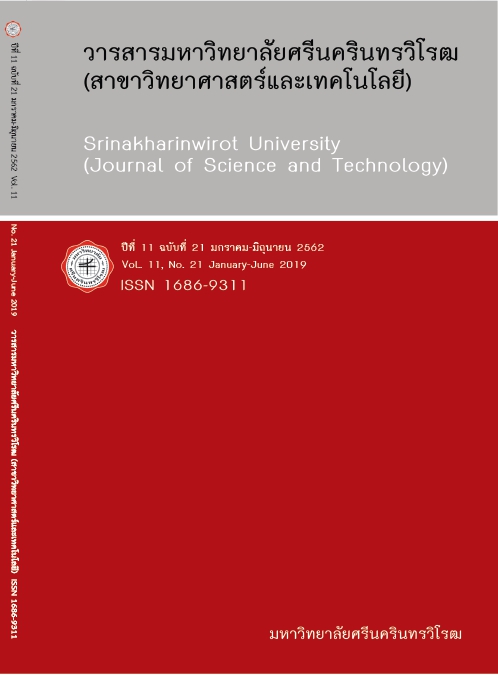แผนภาพความชอบของถั่วงอกและทานตะวันงอกสำหรับผู้บริโภคที่อาศัยในจังหวัดเชียงราย PREFERENCE MAPPING OF MUNG BEAN SPROUTS AND SUNFLOWER SPROUTS FOR CONSUMERS LIVING IN CHIANG RAI
คำสำคัญ:
ถั่วเขียว, ทานตะวัน, ธัญพืชงอก, การยอมรับของผู้บริโภค, แผนภาพความชอบบทคัดย่อ
ความสนใจของผู้บริโภคที่มีต่ออาหารเพื่อสุขภาพมีแนวโน้มเพิ่มมากขึ้นในหลายประเทศรวมถึงประเทศไทย ธัญพืชงอกมีคุณสมบัติในการส่งเสริมสุขภาพและยังช่วยลดความเสี่ยงในการเกิดโรคต่างๆ แม้ทานตะวันงอกจะมีคุณค่าทางโภชนาการและมีประโยชนต่อสุขภาพแต่ปริมาณการบริโภคทานตะวันงอกในประเทศไทยยังคงมีจำนวนจำกัดเมื่อเทียบกับปริมาณการบริโภคถั่วงอก งานวิจัยนี้มีวัตถุประสงค์เพื่อศึกษาการยอมรับของผู้บริโภคและวิเคราะห์ลักษณะบ่งชี้ความชอบที่มีต่อตัวอย่างธัญพืชงอก ถั่วงอกและทานตะวันงอกทั้งแบบสดและผ่านการลวก จำนวน 10 ตัวอย่าง
ถูกทำการประเมินระดับการยอมรับจากการสอบถามผู้บริโภค จำนวน 114 คน ที่เคยรับประทานธัญพืชงอกทั้ง 2 ชนิด วิธีการวิเคราะห์ที่ใช้ประกอบด้วย การวิเคราะห์ด้วยการจัดกลุ่ม การสร้างแผนภาพความชอบภายใน และการวิเคราะห์แบบถดถอย จากผลการจัดกลุ่มผู้บริโภคด้วยคุณลักษณะทางประสาทสัมผัสต่างๆ ประกอบด้วย ความชอบโดยรวม ความชอบในลักษณะปรากฏ ความชอบในกลิ่นรส และความชอบในเนื้อสัมผัส พบว่าในทุกคุณลักษณะสามารถจัดกลุ่มผู้บริโภคได้จำนวน 3 กลุ่มเท่ากัน โดยในลักษณะความชอบโดยรวม ผู้บริโภค 2 ใน 3 กลุ่มชอบตัวอย่างทั้งถั่วงอก
และทานตะวันงอก ขณะที่ผู้บริโภคในกลุ่มที่เหลือชอบตัวอย่างถั่วงอกแบบสดเท่านั้น สำหรับความชอบในลักษณะปรากฏพบว่าตัวอย่างทานตะวันงอกที่ผ่านการลวกเป็นตัวอย่างที่ผู้บริโภคทุกกลุ่มไม่ชอบ นอกจากนั้นยังพบว่าผู้บริโภคหนึ่งในสามกลุ่มชอบลักษณะปรากฏของตัวอย่างถั่วงอกทุกแบบมากที่สุด ขณะที่ผู้บริโภคในอีกกลุ่มให้คะแนนความชอบในลักษณะปรากฏในตัวอย่างทานตะวันงอกสดสูงกว่าตัวอย่างอื่นๆ และในกลุ่มผู้บริโภคกลุ่มที่เหลือชอบลักษณะปรากฏของทั้งถั่วงอกและทานตะวันงอก ในส่วนของความชอบต่อรสชาติพบว่าผู้บริโภคสองกลุ่มมีความชอบที่แตกต่างกันอย่างชัดเจน โดยผู้บริโภคกลุ่มที่หนึ่งชอบกลิ่นรสของตัวอย่างแบบลวกทั้งหมดขณะที่ผู้บริโภคอีกกลุ่มชอบกลิ่นรสของตัวอย่างแบบสดทั้งหมด นอกจากนั้นในกลุ่มผู้บริโภคที่เหลือคือกลุ่มบริโภคที่ชอบกลิ่นรสของทานตะวันงอกทั้งในแบบสดและแบบลวก ในกรณีของความชอบในเนื้อสัมผัสพบแนวโน้มเช่นเดียวกันกับความชอบในกลิ่นรส โดยพบว่าผู้บริโภคในกลุ่มที่หนึ่งชอบเนื้อสัมผัสของตัวอย่างแบบลวกทั้งหมด และในทางตรงข้ามกลุ่มผู้บริโภคอีกกลุ่มกลับชอบลักษณะเนื้อสัมผัสของตัวอย่างแบบสดเท่านั้น โดยกลุ่มผู้บริโภคที่เหลือเป็นกลุ่มที่ชอบเนื้อสัมผัสของถั่วงอกทั้งแบบสดและแบบลวก กลิ่นรสเป็นลักษณะที่เป็นตัวบ่งชี้ที่สำคัญที่สุดต่อระดับความชอบโดยรวม เนื้อสัมผัสเป็นตัวบ่งชี้ที่สำคัญในลำดับที่สอง และลักษณะปรากฏเป็นตัวบ่งชี้ที่มีความสำคัญน้อยที่สุดต่อระดับความชอบโดยรวม ข้อมูลที่ได้จากงานวิจัยนี้เป็นประโยชน์ต่อนักพัฒนาผลิตภัณฑ์และผู้ประกอบการที่ต้องการพัฒนาผลิตภัณฑ์อาหารที่มีส่วนผสมหลักเป็นธัญพืชงอกที่ได้รับการอยมรับจากผู้บริโภคในแต่ละกลุ่ม
Downloads
เอกสารอ้างอิง
[2] Paśko, P., Krośniak, M., Prochownik, E., Tyszka-Czochara, M., Fołta, M., Francik, R., Zagrodzki, P. (2018). Effect of broccoli sprouts on thyroid function, haematological, biochemical, and immunological parameters in rats with thyroid imbalance. Biomedicine & Pharmacotherapy. 97(Supplement C): 82-90.
[3] Lawless, H. T.; & Heymann, H. (2010). Sensory Evaluation of Food: Principles and Practices: Springer New York.
[4] Næs, T., Brockhoff, P.; & Tomic, O. (2011). Statistics for Sensory and Consumer Science: Wiley.
[5] Mac Fie, H. J. H. (2007). Consumer Led Food Product Development: CRC Press.
[6] Carbonell, L., Izquierdo, L., Carbonell, I.; & Costell, E. (2008). Segmentation of food consumers according to their correlations with sensory attributes projected on preference spaces. Food Quality and Preference. 19(1): 71-78.
[7] Xue, D., Zhang, X., Lu, X., Chen, G.; & Chen, Z.-H. (2017). Molecular and Evolutionary Mechanisms of Cuticular Wax for Plant Drought Tolerance. Frontiers in Plant Science. 8(621).
[8] Steinka, I., Barone, C., Parisi, S.; & Micali, M. (2017). Colorimetric Modifications in Frozen Vegetables The Chemistry of Frozen Vegetables (pp. 37-41). Cham: Springer International Publishing.
[9] Fowler, M.W. (2006). Plants, medicines and man. Journal of the Science of Food and Agriculture.86(12): 1797–1804.
[10] Queiroz, C., Mendes Lopes, M., Fialho, E.; and Valente-Mesquita, V. (2008). 'Polyphenol Oxidase: Characteristics and Mechanisms of Browning Control'. Food Reviews International. 24(4): 361-375.
[11] Silva, J., Felberg, I., Carrão-Panizzi, M., Lee, S. Y.; & Prudencio, S. H. (2010). Relationships among sensory analysis, isoflavone and hexanal contents of soymilk powder. Brazilian Archives of Biology and Technology. 53(5): 1197-1204.
[12] Sirimuangmoon, C. (2018). Comparison of Sensory Characteristics of Mung Bean Sprouts and Sunflower Sprouts. Food and Applied Bioscience Journal. 6(Special Issue): 28-44.
[13] Chow, Y., Liew, T. H., Keh, H. H., Ko, A., Puah, S. M., Nguyen, T. B. V., Choi, W. J. (2007). Mung bean lipoxygenase in the production of a C6-aldehyde. Natural green-note flavor generation via biotransformation. Biotechnology Journal. 2(11): 1375-1380.
[13] Chambers, E.; & Koppel, K. (2013). Associations of Volatile Compounds with Sensory Aroma and Flavor: The Complex Nature of Flavor. Molecules. 18(5): 4887.
[14] Panda, H. (2013). The Complete Book on Fruits, Vegetables and Food Processing: NIIR PROJECT CONSULTANCY SERVICES.
ดาวน์โหลด
เผยแพร่แล้ว
รูปแบบการอ้างอิง
ฉบับ
ประเภทบทความ
สัญญาอนุญาต
วารสารมหาวิทยาลัยศรีนครินทรวิโรฒ สาขาวิทยาศาสตร์และเทคโนโลยี อยู่ภายใต้การอนุญาต Creative Commons Attribution-NonCommercial-NoDerivs 4.0 International (CC-BY-NC-ND 4.0) เว้นแต่จะระบุไว้เป็นอย่างอื่น โปรดอ่านหน้านโยบายของวารสารสำหรับข้อมูลเพิ่มเติมเกี่ยวกับการเข้าถึงแบบเปิด ลิขสิทธิ์ และการอนุญาต



